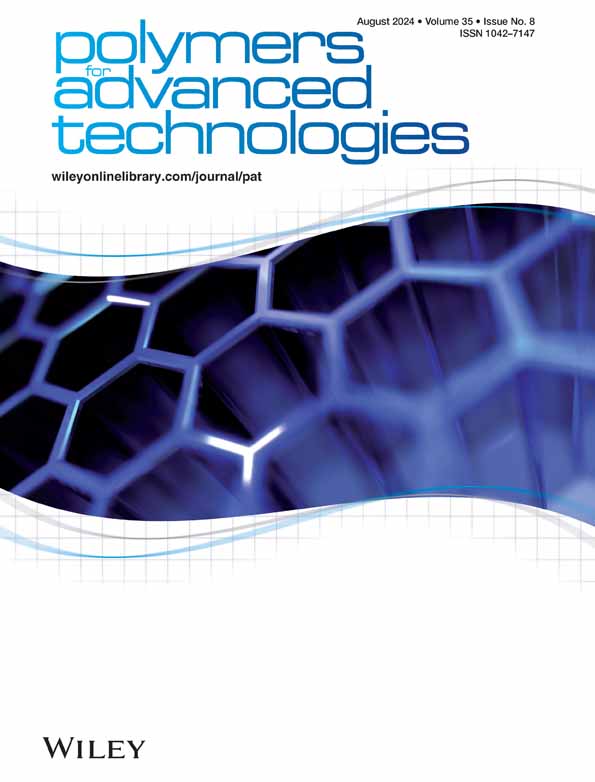Preparation, characterization, and antistatic applications of high‐density polyethylene/polyaniline blends
IF 3.4
4区 工程技术
Q2 POLYMER SCIENCE
引用次数: 0
Abstract
To obtain electrostatic charge dissipative (ESD) materials, high‐density polyethylene (HDPE) and polyaniline (PANI) blends are synthesized by the solution blending method. To prepare the blends, 0.5, 1.0, and 3.0 wt% of PANI are introduced into the HDPE matrix. The prepared blends are investigated by Fourier transform infrared (FTIR) spectroscopy, X‐ray diffraction (XRD), differential scanning calorimetry (DSC), and thermogravimetric analysis (TGA), and scanning electron microscope (SEM). Additionally, stress–strain curves are used to examine the blends' mechanical properties. Polyaniline additions indicated an increase in thermal stability by approximately 1°C in the blends but decrease in mechanical properties. The four‐probe technique is used to determine the electrical conductivity of blends, which is found to be between 10高密度聚乙烯/聚苯胺混合物的制备、表征和抗静电应用
为了获得静电消散(ESD)材料,采用溶液混合法合成了高密度聚乙烯(HDPE)和聚苯胺(PANI)混合物。为了制备混合物,在高密度聚乙烯基体中引入了 0.5、1.0 和 3.0 wt%的 PANI。傅立叶变换红外光谱(FTIR)、X 射线衍射(XRD)、差示扫描量热法(DSC)、热重分析(TGA)和扫描电子显微镜(SEM)对所制备的共混物进行了研究。此外,还利用应力-应变曲线来检测共混物的机械性能。添加聚苯胺后,混合物的热稳定性提高了约 1°C,但机械性能却有所下降。四探针技术用于测定共混物的电导率,发现其介于 10-7 和 10-10 S/cm 之间。电导率值的结果表明,所有混合物都具有作为抗静电材料的巨大潜力。在抗静电应用中,混合物的静电放电性能是在不同电晕电压下测定的。混合物达到了抗静电要求,10%截止衰减时间约为 2.0 秒,1/e 时间约为 1.0 秒,表明静电荷消散迅速。根据抗静电衰减时间,本研究获得的所有混合物均可在 3 kV 电晕电压下用作抗静电材料。
本文章由计算机程序翻译,如有差异,请以英文原文为准。
求助全文
约1分钟内获得全文
求助全文
来源期刊

Polymers for Advanced Technologies
工程技术-高分子科学
CiteScore
6.20
自引率
5.90%
发文量
337
审稿时长
2.1 months
期刊介绍:
Polymers for Advanced Technologies is published in response to recent significant changes in the patterns of materials research and development. Worldwide attention has been focused on the critical importance of materials in the creation of new devices and systems. It is now recognized that materials are often the limiting factor in bringing a new technical concept to fruition and that polymers are often the materials of choice in these demanding applications. A significant portion of the polymer research ongoing in the world is directly or indirectly related to the solution of complex, interdisciplinary problems whose successful resolution is necessary for achievement of broad system objectives.
Polymers for Advanced Technologies is focused to the interest of scientists and engineers from academia and industry who are participating in these new areas of polymer research and development. It is the intent of this journal to impact the polymer related advanced technologies to meet the challenge of the twenty-first century.
Polymers for Advanced Technologies aims at encouraging innovation, invention, imagination and creativity by providing a broad interdisciplinary platform for the presentation of new research and development concepts, theories and results which reflect the changing image and pace of modern polymer science and technology.
Polymers for Advanced Technologies aims at becoming the central organ of the new multi-disciplinary polymer oriented materials science of the highest scientific standards. It will publish original research papers on finished studies; communications limited to five typewritten pages plus three illustrations, containing experimental details; review articles of up to 40 pages; letters to the editor and book reviews. Review articles will normally be published by invitation. The Editor-in-Chief welcomes suggestions for reviews.
 求助内容:
求助内容: 应助结果提醒方式:
应助结果提醒方式:


